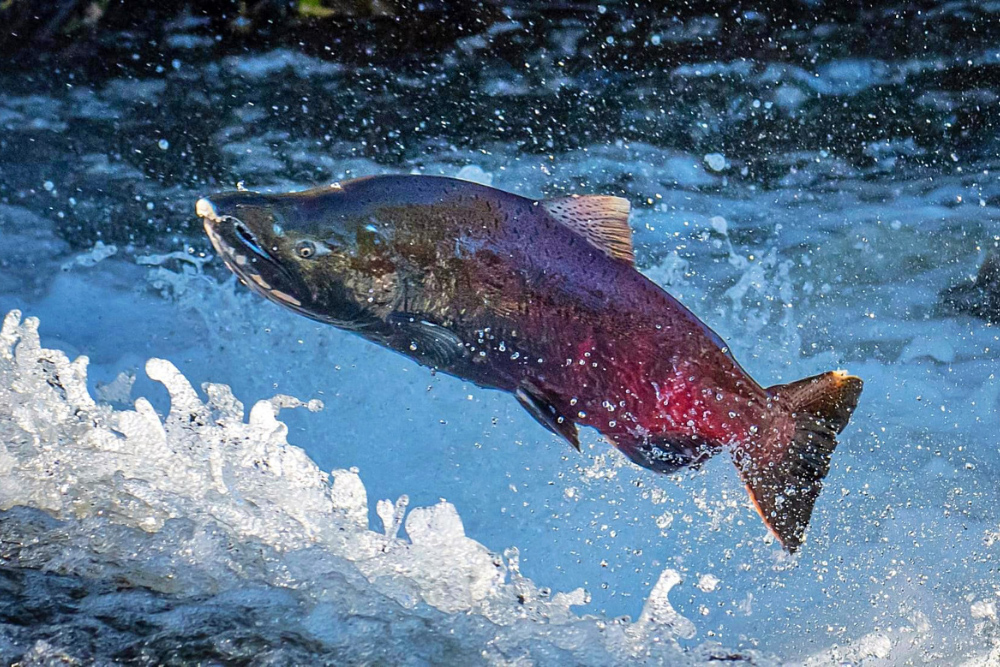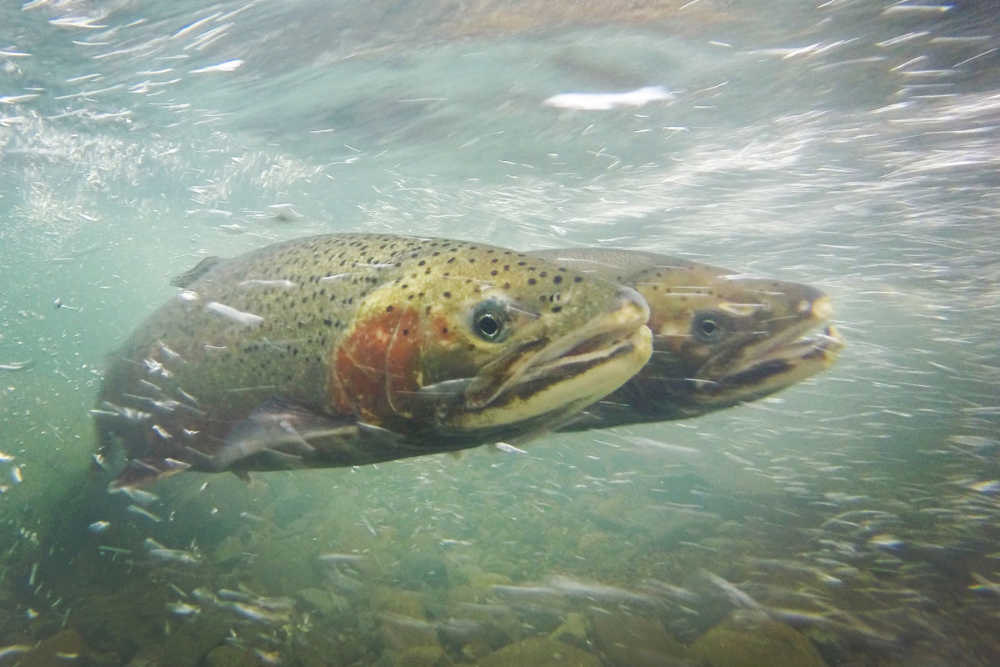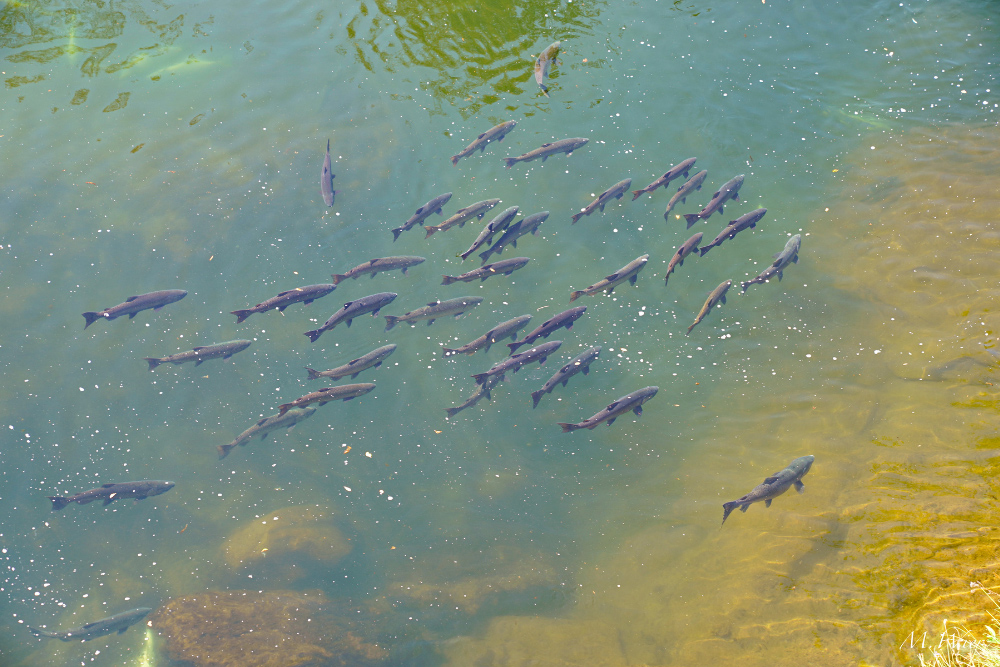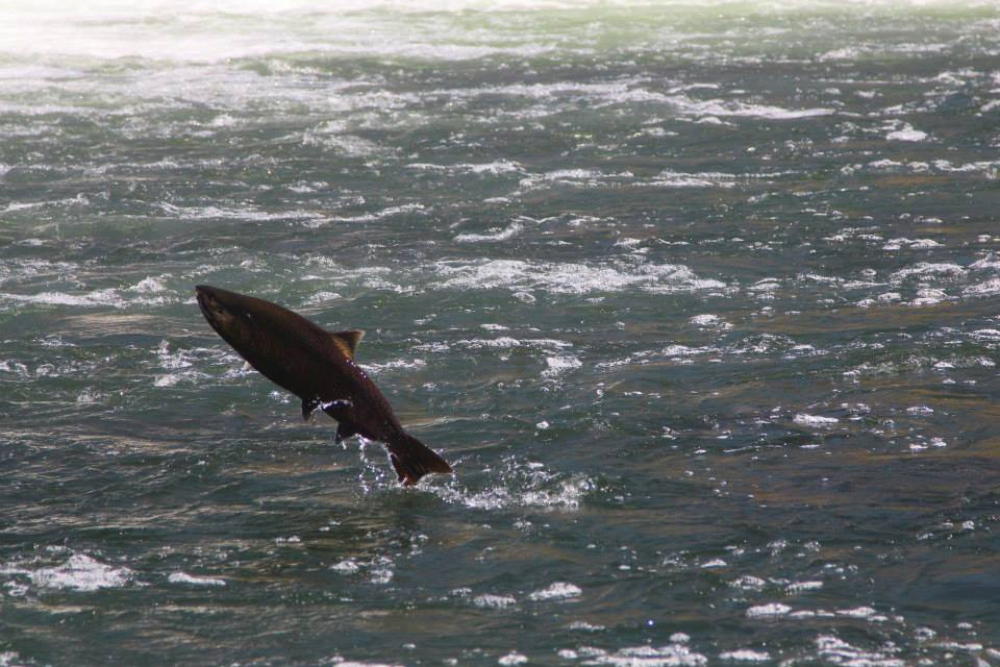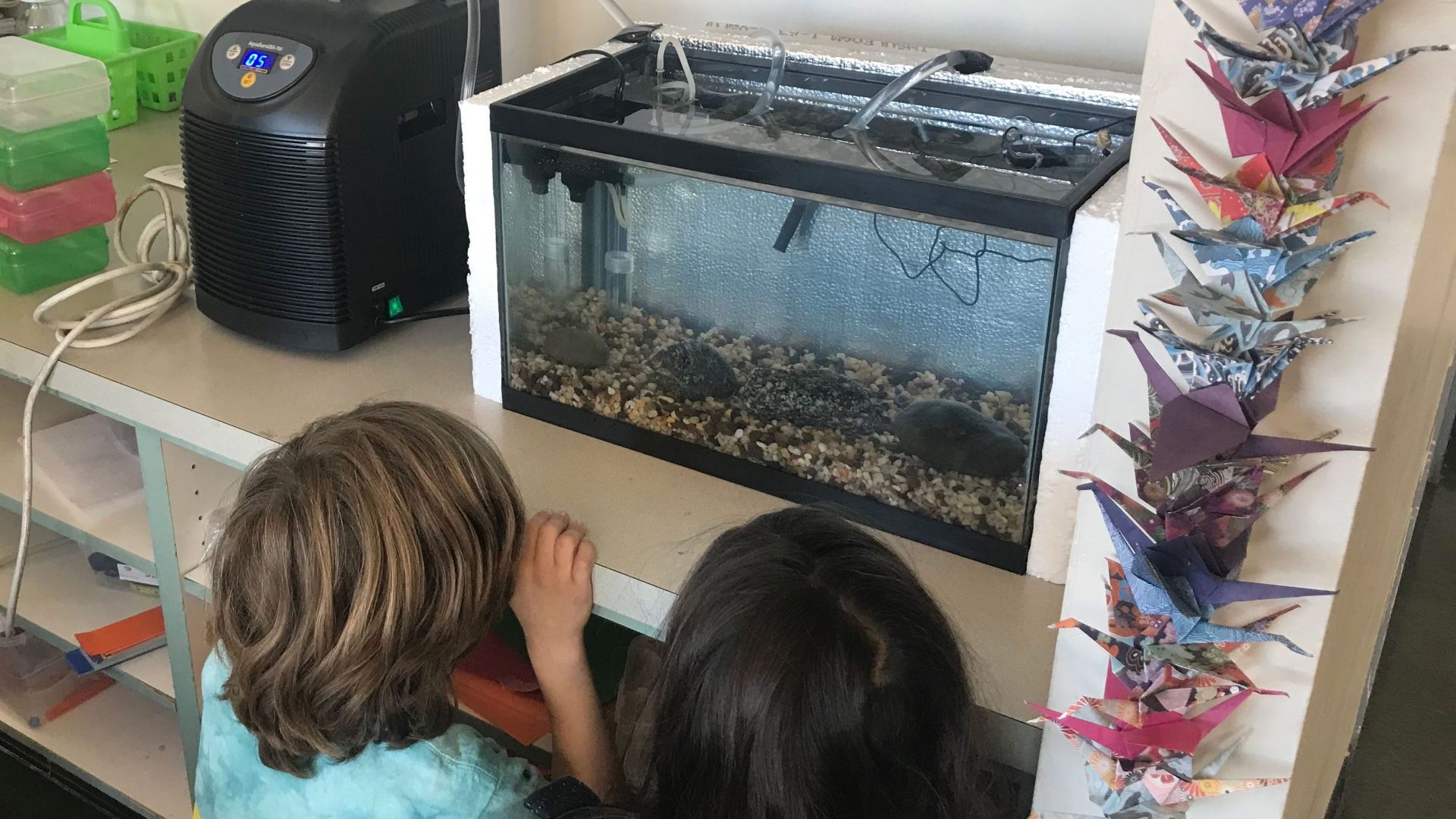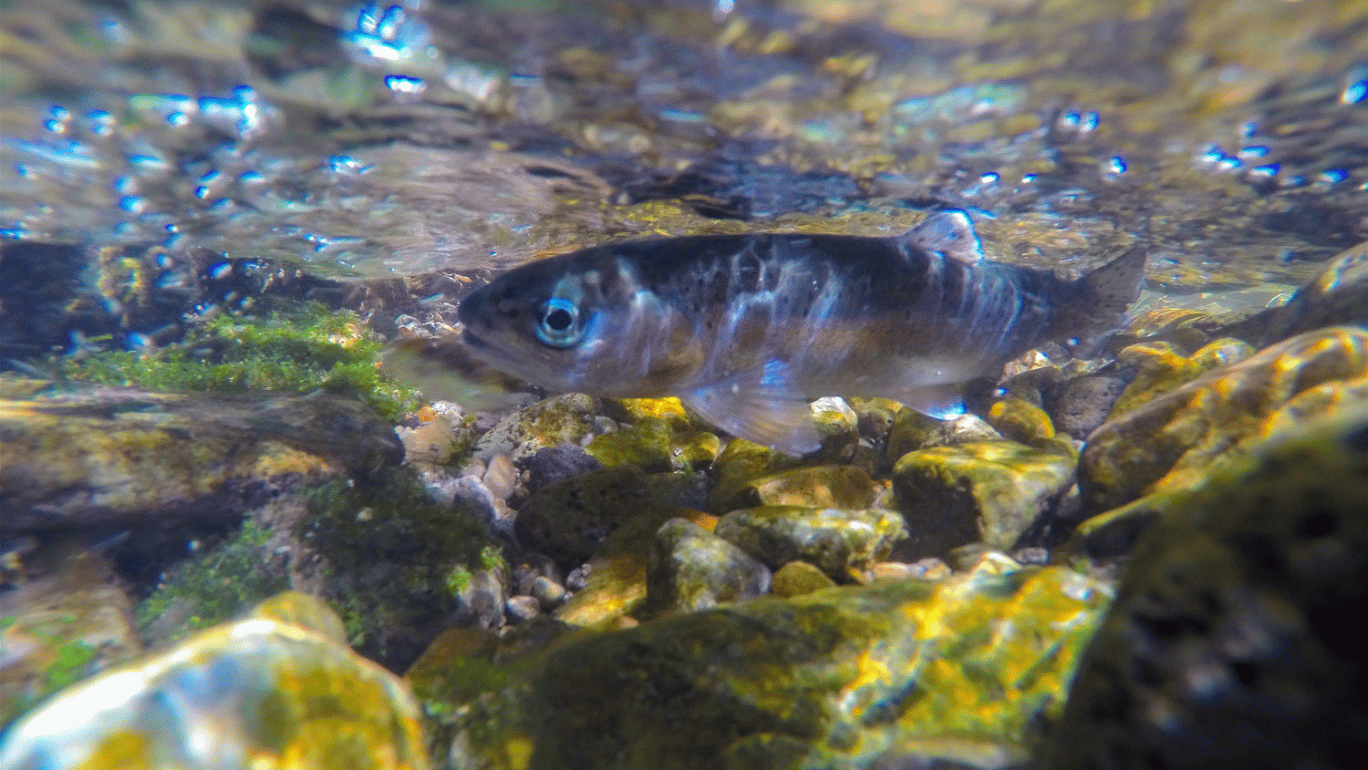“We've heard stories of the salmon so thick that they couldn't all fit in the creek, and they would fly out on the ground,” says McHenry, the Mechoopda Indian Tribe’s Cultural Director and Tribal Historic Preservation Officer. “Our people would pick them up and take them back home.”
It’s November in Upper Bidwell Park, just east of the City of Chico. Bidwell Park is one of the largest municipal parks in the country, and many describe it as the crown jewel of Chico. The park is divided into two segments. Lower Bidwell Park runs through downtown Chico offering paved paths and a man-made concrete swimming pool built into the creek. Upper Bidwell Park is a rural landscape where the creek flows through towering canyons with natural swimming holes. McHenry stands in Upper Bidwell Park, above Iron Canyon, near Udawi, the beginning.
“This area is called Udawi because it’s the beginning of the foothills and the beginning of the valley. There are valley oaks (ló:wi) and blue oaks (c̉àk̉awì) here,” McHenry says. He is one of the few remaining speakers of the Tribe’s language, Northwestern Maidu.
Like the Tribe’s language, the salmon too have all but disappeared. Years ago, the salmon were not only numerous, but they could also traverse over 24 miles of Ótakim Séwi from its confluence with the Sacramento River to a natural waterfall barrier above Iron Canyon at Higgins Hole. Today, salmon and other fish cannot travel more than 13 miles upstream. Fallen boulders and a defunct fish ladder at Iron Canyon force fish to stop their migration and turn around.
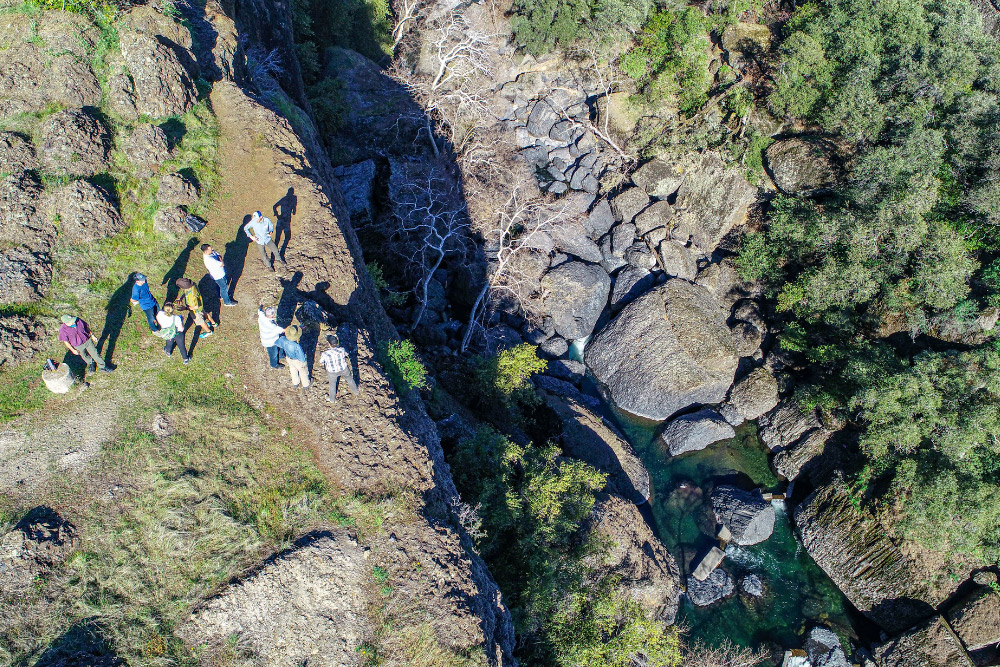
Kyle McHenry and project partners gather at the edge of Iron Canyon.
Goodman brought CalTrout together with the Mechoopda Tribe, Chico State’s Big Chico Creek Ecological Reserve, the California Department of Fish and Wildlife, the City of Chico, the U.S. Fish and Wildlife Service, and interested community members to hatch the idea. Continuing to move the project forward, CalTrout set out to hire a full-time staff member, based in Chico. In 2021, Chico resident Holly Swan joined CalTrout as Project Manager of the organization’s new Mt. Lassen Region. Swan’s local expertise provides CalTrout with a solid foundation to engage in this project and to deepen CalTrout’s involvement in the area. The project team expanded to bring in contractors and consulting firms crucial to the project’s success including: Syblon Reid, Mike Love and Associates, Gallaway Enterprises, FISHBIO, Western Fishes, Maxim Crane Works, Gayland Taylor, and NV5.
"We've heard stories of the salmon so thick that they couldn't all fit in the creek, and they would fly out on the ground."
KYLE MCHENRY
“Reopening habitat to fish migration is crucial for the recovery of salmon and steelhead populations, and for building their resilience to future climate conditions,” says Carrie Selberg Robinson, director of the NOAA Fisheries Office of Habitat Conservation. “NOAA is proud to be working together on this project supporting high-priority efforts to recover these species."
NOAA recommended more than $87 million funding for 23 projects selected through the Restoring Fish Passage through Barrier Removal funding opportunity, including the Iron Canyon Fish Passage Project.
“I have dedicated the last 20 years of my career to conserving fishes,” says Goodman. “This project takes an ecosystem-based approach to restoration of the entire native fish fauna in Big Chico Creek. CalTrout will be working with the project team to make sure the project benefits the entire watershed and all its inhabitants, including the people of Chico who are devoted to Bidwell Park. I’m really excited to be part of the team, working together to accomplish a task like this.”
Accelerated Restoration at Big Chico Creek & Beyond
Many restoration projects across the state are funded in stages, through multiple grants, but the Iron Canyon Fish Passage Project received funding through a single grant to cover all stages – from planning through to construction. This funding model can significantly reduce administrative burdens and timing delays associated with separate grants. It accelerates restoration on Big Chico Creek and provides an example for accelerating restoration work statewide. For this project, CalTrout also relies on the work of our partner organization Sustainable Conservation and their collaboratively developed Statewide Tools to Accelerate Aquatic Habitat Restoration. Tools like this help simplify permitting processes, reduce costs, and further accelerate restoration at Big Chico Creek and beyond.“This is the most streamlined way that I can think of to get something from concept to construction,” Goodman says. “Together we are building a more efficient approach to restoration.”
“I have a vision of anadromous fish swimming their way through Chico up to the Ecological Reserve within five years,” Goodman says.
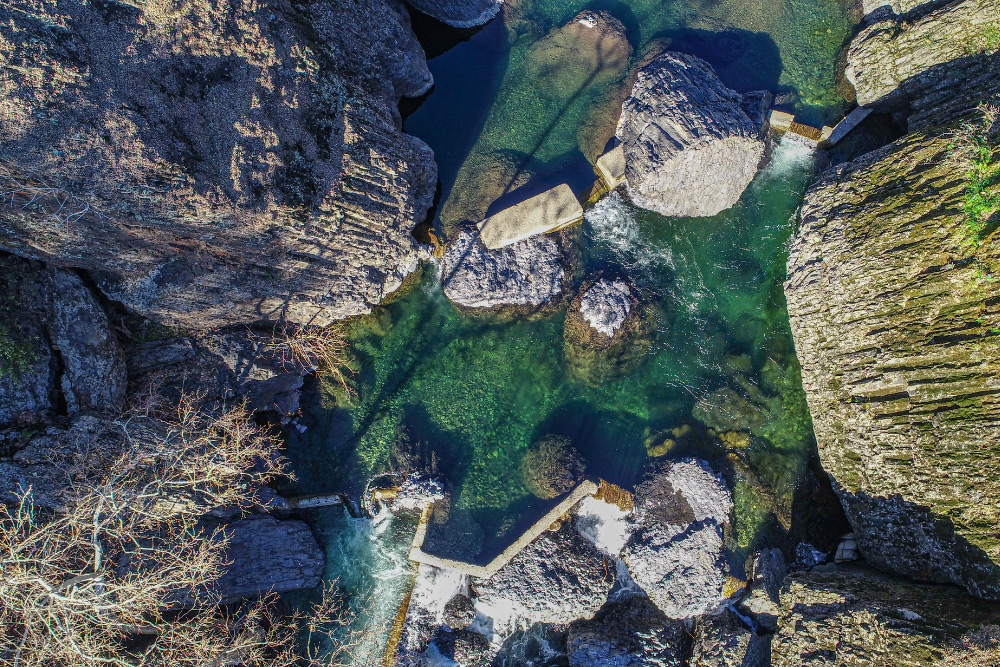
Currently, the fish ladder is unmaintained, damaged by boulders shifted by hydraulic forces, and, as a result, largely impassable to fish.
Beyond the benefits of restoring healthy fish populations in Chico, the project will provide educational opportunities to students at Chico State University and Butte Community College, as well as K-12 students and the public. Hundreds of thousands of people visit Bidwell Park each year, enabling the project to reach a diverse and widespread audience. Educational opportunities will provide insight into Traditional Ecological Knowledge practices, habitat restoration, and fish passage remedies. In addition, over 1,000 local students will be engaged in the restoration effort every year of the project, giving them a personal connection to Big Chico Creek and building a long-lasting conservation ethic.
“The end goal for us is to give our kids a sense of connection to this place and a feeling of ownership over it,” McHenry says. “We want to give them a connection to our ancestors who lived off of and stewarded this land and water.”
The project will fund more than 60 local jobs from a wide range of disciplines, from engineering, surveying, and construction to science and education.
“Projects like this may seem daunting, but CalTrout and our partners are experienced doing this in other places,” Goodman says. At Eagle Canyon on Battle Creek, the team recently completed a similar project that opened eight miles of anadromous habitat. “We are taking that same concept and transposing it on a new problem.”
"Anadromous salmonids are an intrinsic part of who we are as a people, both culturally and spiritually."
HE-LO RAMIREZ
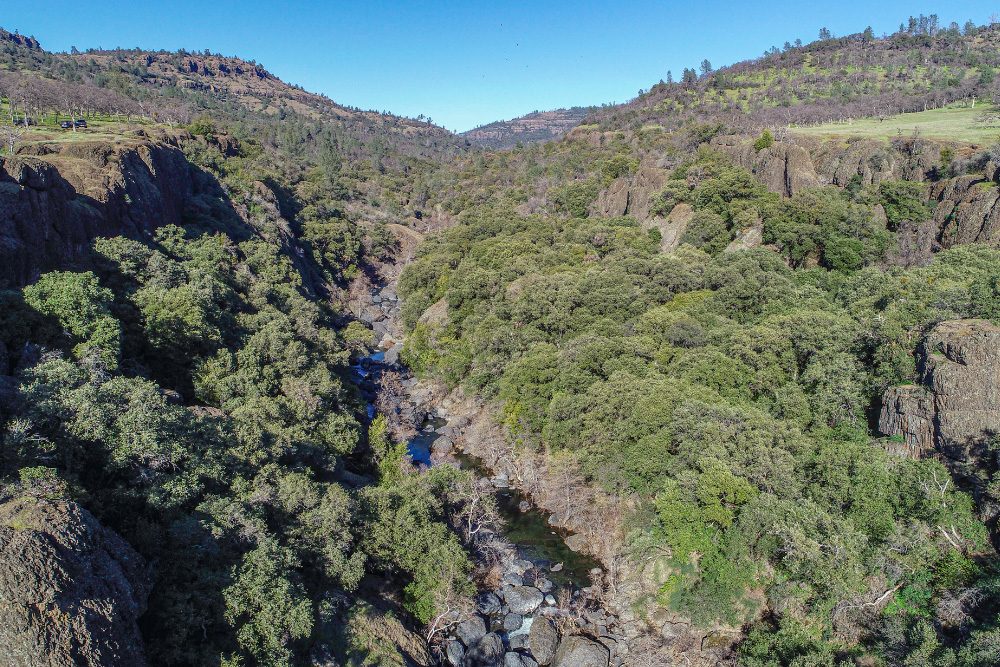
Big Chico Creek flows between giant cliff sides at Iron Canyon.
“This is native buckwheat,” he says. Buckwheat thrives across Butte County, decorating the landscape in white and soft pink lace as it blooms in the summer and fall months. “But there’s a lot of invasive star thistle and other invasives out here too.”
Many of these invasive plants will be cleared when project construction at Iron Canyon begins, making space for more native plants on the landscape.
“When the cranes come in and it clears out to bare soil, we will be able to bring native plants back in, and we can bring in an educational piece too. For the Tribe, this allows us to feel like we are invested because we are a part of the process not just sitting on the outside. That gives us a feeling of ownership over the project,” McHenry says.
The Mechoopda Tribe are involved in the project from beginning to end, providing perspective and knowledge throughout the process. After stream channel restoration work has been completed, the Tribe will provide a Traditional Ecological Knowledge (TEK) crew to help re-introduce native plant species. The TEK crew holds deep knowledge of the landscape from thousands of years of direct contact with the land and knowledge, practices, and beliefs passed down through generations.
Since time immemorial, the Mechoopda people have occupied the Ótakim Séwi (Big Chico Creek) watershed, the Eskenim Séwi (Butte Creek) watershed, as well as both banks of the Séwote:m (Sacramento River) in what is now Butte and Glenn Counties.
“I am delighted to be working on this project as not only a strong project supporter but also as a project partner,” says He-Lo Ramirez, the Mechoopda Tribe’s Director of Environmental Planning & Protection. “Our people since time immemorial have been sustained largely by anadromous salmonids and acorns, and pre-colonization we intentionally managed, and continue to do so today, the waters and lands within our traditional cultural landscape with the purpose of increasing biodiversity and maintaining healthy ecosystems. We are happy to further continue that long tradition today as a project partner of the Iron Canyon project.”
Iron Canyon hosts a multitude of species of high cultural importance to the Tribe including but not limited to; c̉àk̉awì (blue oak), ló:wi (valley oak), wàji (edible geophyte non-allium), p̉áli:k̉i (rainbow trout/steelhead), sójbam (California Bay laurel), and máji (salmon), He-Lo explains.
“Anadromous salmonids are an intrinsic part of who we are as a people, both culturally and spiritually, and as we revitalize our culture and lifeways it is our duty to revitalize our salmon kin who have supported us since time immemorial,” He-Lo says.
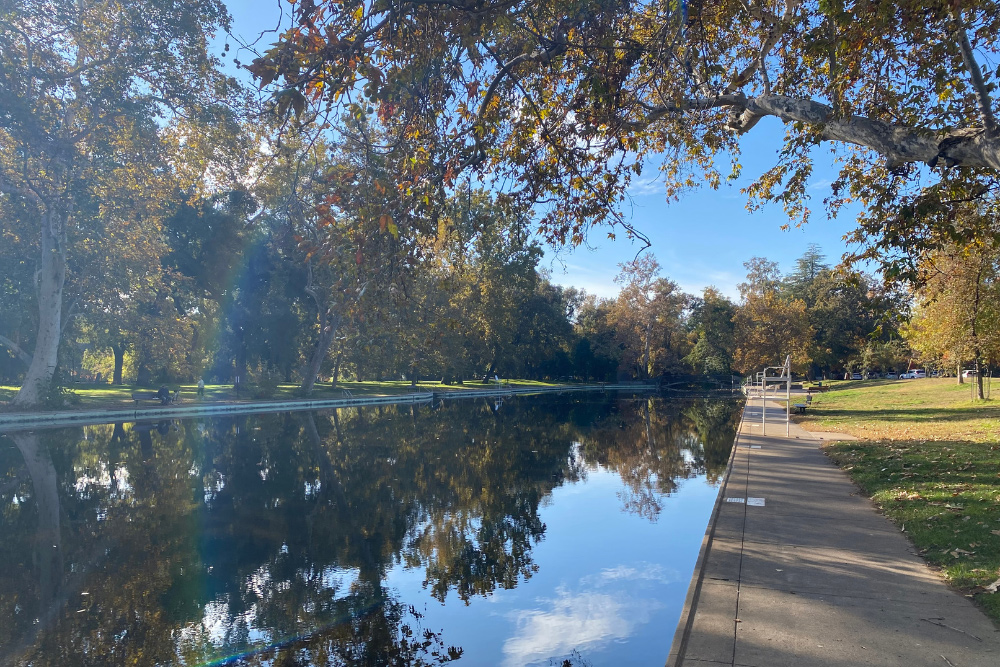
In Lower Bidwell Park, a man-made swimming pool, built into the creek, attracts many visitors in the summer.
The City of Chico manages the creek from Bidwell Mansion, in town, all the way up to where the BCCER begins. In the Parks managed section of the creek, there are five different swimming holes. Yahi Trail, popular for hiking, follows the creek through Upper Bidwell Park.
“The watershed is very important to the community and to the park,” says Linda Herman, Manager of Parks and Natural Resources for the City of Chico. “For years, the Mechoopda Tribe have stewarded the land. There’s always been a long-standing interest in the watershed, as well as the salmon and fish in the creek.”
The fish passage project is considered a top priority in the Bidwell Park Master Management Plan. As the landowner of the project site, the city plays an active role in the project and will provide support in communicating project plans and updates to Chico residents.
"The salmon have sustained our people for thousands of years, and they are the reason we are alive today. They are a part of our DNA."
KYLE MCHENRY
“When I heard CalTrout was expanding into this region and was taking on a fish passage project in Iron Canyon, I knew I had to be part of it,” she says. In 2022, Swan started as Project Manager for CalTrout’s Mt. Lassen region. Today, she leads the Iron Canyon Fish Passage Project team. “I am extremely thrilled to be partnering with the Chico State Ecological Reserve on this project as a two-time Chico State alum. But most of all, I am excited to see the cascading ecological effects these migratory fish will bring to the entire ecosystem in Bidwell Park.”
Because these ocean-going migratory fish are keystone species, the entire ecosystem of Upper Bidwell Park, which surrounds the project, will be revitalized as fish populations rebound. Raptors, bears, and other natural fish predators will benefit, and fish will carry nutrients up from the ocean to enrich the soil and native plants.
“For the health of the watershed and the landscape, we know we need to bring more native fish and salmon back into Big Chico Creek,” says Eli Goodsell, director of Chico State University’s Ecological Reserves. “A return of fish will in turn support our birds of prey and mammalian predators and will ultimately impact multiple aspects of the food web.”
The Ecological Reserve’s 8,000 acres provide a living laboratory for students and community members to learn about and interact with the land and water that surround them. Every year, over 2,400 university students visit the Reserve. Goodsell also runs an interdisciplinary Wildlands Master’s program at the Reserve through which students design projects related to all different aspects of wildland stewardship. Through an outdoor education program, over 1,300 primary and secondary grade school students visit the Reserve each year. Goodsell hopes that this program can show young students how many different opportunities and paths there are towards land stewardship work.
“We view our role as developing the next generation of land stewards and conservationists in the Western United States,” he says. “And everything we do at Big Chico Creek Ecological Reserve centers on the health of the watershed.”
The Reserve holds vast knowledge of the landscape surrounding Big Chico Creek, but it does not specialize in fish passage project implementation knowledge. This makes a partnership between the Reserve and CalTrout mutually beneficial. While CalTrout handles the project work, the Reserve can help develop a community education plan through on-the-ground presence and through partners that they have already built trusting relationships with.
“Finding somebody like CalTrout was exactly what we needed to move this project forward,” Goodsell says.

Big Chico Creek is a major artery for the Chico community.
“The salmon have sustained our people for thousands of years, and they are the reason we are alive today,” McHenry says. “They are a part of our DNA. Being able to see this project go through to help the salmon – and to see them thrive – is paramount for the Tribe.”
Before climbing back into his truck and leaving Iron Canyon behind for the day, McHenry points to a rock that his nine-year old daughter sits on. He asks her a question in Northwestern Maidu. With a shy smile, she responds back in their shared language.
“I’m pretty much the last conversational speaker of the Mechoopda, but we’re doing language classes right now,” he says, gesturing to both his children. “These guys are learning.”

